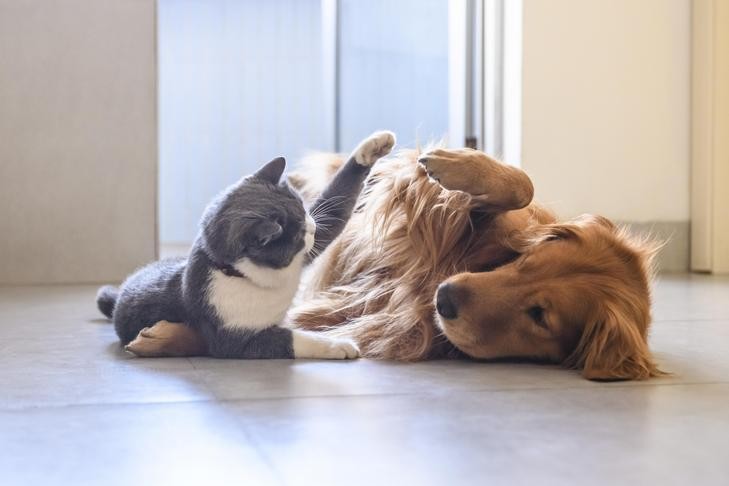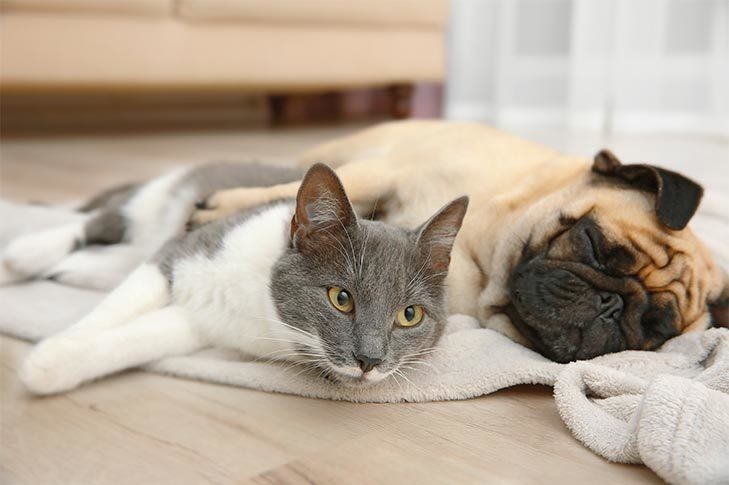Can Dogs Learn To Like Cats? Absolutely! This comprehensive guide from LEARNS.EDU.VN explores how to foster a harmonious relationship between your canine and feline companions using positive reinforcement and strategic introductions. Understanding canine behavior, feline habits, and utilizing effective training techniques are key to a successful multi-pet household. Learn about socialization methods, training tips, and long-term strategies for creating a peaceful co-existence.
1. Understanding the Potential for Harmony
The age-old saying “fighting like cats and dogs” doesn’t have to be your reality. While inherent differences exist, the potential for a peaceful, even loving, relationship between dogs and cats is absolutely achievable. Success hinges on understanding the individual personalities of your pets, implementing proper introduction strategies, and consistently reinforcing positive interactions. Breeds, socialization and careful management are all factors to consider when establishing a happy environment.
1.1. Socialization: The Foundation of Friendship
Early socialization is paramount. Puppies exposed to cats early in life are significantly more likely to accept them as part of their social group. Similarly, kittens raised around dogs tend to be more comfortable in their presence. However, even without early socialization, positive interactions can be cultivated with consistent effort and patience.
1.2. Breed Considerations: Some Breeds are More Inclined to Befriend Felines
Certain dog breeds, due to their temperament and lower prey drive, are naturally more inclined to get along with cats. These include:
- Golden Retrievers: Known for their gentle nature and eagerness to please.
- Labrador Retrievers: Similar to Goldens, they are friendly and adaptable.
- Bichon Frises: Small, playful, and generally good with other animals.
- Poodles: Intelligent and easily trained, they can learn to coexist peacefully.
- Newfoundlands: Gentle giants known for their patience and tolerance.
However, even with these breeds, proper training and supervision are still essential.
1.3. Individual Personalities: A Critical Factor
Beyond breed, individual personalities play a significant role. Some dogs simply have a higher prey drive or are less tolerant of cats. Similarly, some cats are more independent and less willing to interact with dogs. Understanding your pets’ individual temperaments will allow you to tailor your approach for optimal success.
2. Laying the Groundwork: Preparing for a Successful Introduction
Rushing the introduction process can lead to fear, anxiety, and potentially aggressive behavior. Patience and a gradual approach are crucial.
2.1. Separate Spaces: The First Few Days
Upon bringing a new dog or cat into the household, immediately segregating them is vital. This allows each pet to acclimate to the new environment and each other’s scent without direct interaction. Provide each animal with its own “safe space” – a designated area like a bedroom or crate – complete with food, water, a bed, and toys.
2.2. Scent Swapping: Familiarizing Through Smell
Smell is a powerful sense for both dogs and cats. Exchanging scents helps them become accustomed to each other before a face-to-face meeting.
Methods for Scent Swapping:
| Method | Description |
|---|---|
| Blanket Exchange | Swap blankets between the dog’s and cat’s sleeping areas, allowing them to sleep with the other’s scent. |
| Toy Rotation | Rotate toys between the two animals so each can get used to the smell. |
| Rubbing with a Cloth | Gently rub a cloth on one pet and then place it in the other’s area. |
| Under-the-Door Sniffing | Allow the dog and cat to sniff each other under the door, gradually increasing the duration of the interaction. |


2.3. Positive Associations: Linking Scents to Rewards
Create positive associations with the other animal’s scent by pairing it with rewards. For example, when the dog is near the cat’s blanket, offer a high-value treat. Similarly, give the cat a tasty treat when it’s near the dog’s bed. This helps them associate the other animal with positive experiences.
2.4. Feeding Near the Door: Gradual Proximity
After a few days of scent swapping, begin feeding the dog and cat on opposite sides of the closed door. Start with the food bowls a few feet away and gradually move them closer as they become more comfortable. This helps them associate the other animal with mealtime, a naturally positive experience.
3. The First Meeting: Controlled and Supervised
The first face-to-face meeting should be carefully controlled and supervised to ensure the safety and well-being of both animals.
3.1. Barrier Introductions: Safety First
Use a physical barrier like a baby gate or screen door for the initial introduction. This allows the dog and cat to see and interact with each other without the risk of chasing or aggression. Observe their body language closely. Signs of stress or anxiety include:
- Dog: Stiff body posture, growling, barking, lunging.
- Cat: Hissing, spitting, flattened ears, dilated pupils, arched back.
If either animal exhibits these signs, separate them immediately and try again later.
3.2. Leashed Introductions: Maintaining Control
If the barrier introduction goes well, proceed to a leashed introduction in a neutral area. Keep the dog on a leash and maintain a firm grip. Allow the cat to roam freely so it has the option to escape if needed.
3.3. Short and Sweet: Keeping Interactions Brief
Keep the initial interactions short, lasting only a few minutes. Gradually increase the duration as they become more comfortable. End each session on a positive note, even if it means separating them before any signs of tension arise.
3.4. Positive Reinforcement: Rewarding Calm Behavior
Throughout the introduction process, reward both the dog and cat for calm and peaceful behavior. Use treats, praise, or gentle petting. This reinforces the idea that being around the other animal leads to positive outcomes.
4. Training is Key: Establishing Boundaries and Expectations
Training is essential for teaching your dog how to behave appropriately around the cat. Focus on commands that promote calmness and self-control.
4.1. “Leave It”: Respecting Boundaries
The “leave it” command is invaluable for teaching your dog to ignore the cat. Start by teaching the command with a treat. Place a treat on the floor and cover it with your hand. When your dog tries to get the treat, say “leave it.” Once your dog backs away, give them a different treat from your other hand. Gradually progress to leaving the treat uncovered and eventually using the command with the cat in sight.
4.2. “Sit” and “Stay”: Promoting Calmness
The “sit” and “stay” commands are excellent for promoting calm behavior around the cat. Ask your dog to sit or stay when the cat is nearby and reward them for complying. This helps them associate the cat with following your commands and receiving positive reinforcement.
4.3. Redirecting Chase Behavior: Alternative Outlets
Chasing is a natural instinct for many dogs. To prevent them from chasing the cat, redirect their energy towards appropriate outlets. Provide them with plenty of opportunities to play fetch, chase toys, or engage in other forms of exercise.
4.4. The Power of Positive Reinforcement
Remember to use positive reinforcement techniques throughout the training process. Reward your dog for good behavior with treats, praise, and affection. Avoid punishment, as it can create fear and anxiety, making the situation worse.
5. Creating a Harmonious Living Environment
Even after successful introductions and training, it’s important to create a living environment that caters to the needs of both your dog and cat.
5.1. Cat-Only Zones: Safe Havens for Felines
Provide your cat with a designated “cat-only zone” where the dog is not allowed. This could be a separate room, a tall cat tree, or a series of shelves that the dog cannot access. This gives the cat a safe haven where they can retreat when they need space.
5.2. Vertical Space: Empowering the Cat
Cats feel safer when they have access to vertical space. Provide them with cat trees, shelves, or window perches where they can observe their surroundings from a higher vantage point.
5.3. Separate Feeding Areas: Preventing Food Aggression
Feed your dog and cat in separate areas to prevent food aggression. Consider feeding the cat on a high surface that the dog cannot reach.
5.4. Litter Box Placement: Privacy and Accessibility
Place the cat’s litter box in a location that is easily accessible to the cat but out of reach of the dog. Some dogs are tempted to eat cat feces, which can be harmful to their health.
5.5. Monitoring Interactions: Ongoing Supervision
Even after your dog and cat appear to be getting along, continue to monitor their interactions, especially when you are not home. Look for any signs of stress or tension and intervene if necessary.
6. Addressing Potential Challenges
Despite your best efforts, some challenges may arise. Understanding how to address these issues can help maintain peace in your multi-pet household.
6.1. Jealousy: Ensuring Equal Attention
Jealousy can occur if one pet feels they are not getting enough attention. Make sure to give both your dog and cat equal amounts of love, affection, and playtime.
6.2. Resource Guarding: Protecting Possessions
Resource guarding occurs when one pet tries to protect their food, toys, or bed from the other. To address this, feed them in separate areas and provide them with their own set of toys and bedding.
6.3. Aggression: Seeking Professional Help
If aggression persists despite your efforts, seek professional help from a certified dog trainer or veterinary behaviorist. They can help you identify the underlying cause of the aggression and develop a tailored treatment plan.
7. The Benefits of a Multi-Pet Household
While introducing a dog and cat can be challenging, the rewards are well worth the effort. A harmonious multi-pet household can bring joy, companionship, and endless entertainment to your life.
7.1. Increased Activity: Encouraging Playfulness
Having both a dog and cat can encourage increased activity and playfulness in both animals. They may chase each other, wrestle, or engage in other forms of playful interaction.
7.2. Reduced Loneliness: Providing Companionship
Pets can provide companionship and reduce feelings of loneliness, especially for people who live alone. A dog and cat can keep each other company when you are not home, reducing the risk of separation anxiety.
7.3. Enhanced Socialization: Learning to Interact
Living with another species can enhance socialization skills in both dogs and cats. They learn to communicate, cooperate, and navigate social situations with members of a different species.
8. Expert Tips for Success
Here are some additional expert tips to help you succeed in creating a harmonious relationship between your dog and cat:
- Be Patient: It takes time for dogs and cats to adjust to each other. Don’t get discouraged if you don’t see results immediately.
- Be Consistent: Consistency is key to success. Follow the same routine and rules every day.
- Be Observant: Pay close attention to your pets’ body language and behavior. Intervene if you see any signs of stress or tension.
- Be Positive: Maintain a positive attitude throughout the process. Your pets will pick up on your energy and be more likely to succeed.
- Consult a Professional: If you are struggling to introduce your dog and cat, don’t hesitate to consult a professional dog trainer or veterinary behaviorist.
9. Essential Tools for a Smooth Transition
Having the right tools can make the introduction process smoother and more successful.
9.1. Baby Gates: Creating Safe Zones
Baby gates are essential for creating separate zones and controlling interactions between your dog and cat.
9.2. Leashes and Harnesses: Maintaining Control
Leashes and harnesses are necessary for supervised introductions and training sessions.
9.3. Cat Trees and Shelves: Providing Vertical Space
Cat trees and shelves give your cat a safe space to retreat and observe their surroundings from a higher vantage point.
9.4. Puzzle Toys: Mental Stimulation and Distraction
Puzzle toys can provide mental stimulation and distraction for both your dog and cat, reducing the likelihood of boredom and destructive behavior.
9.5. Calming Aids: Reducing Anxiety
Calming aids such as pheromone diffusers or calming treats can help reduce anxiety and stress in both your dog and cat.
| Tool | Description | Benefit |
|---|---|---|
| Baby Gates | Creates physical barriers to separate spaces. | Allows for safe, controlled introductions and provides safe zones. |
| Leashes & Harnesses | Enables controlled movement during initial interactions. | Prevents chasing and allows for training in a safe environment. |
| Cat Trees | Offers elevated spaces for cats to feel secure. | Provides a retreat for cats, reducing stress and promoting a sense of control. |
| Puzzle Toys | Provides mental stimulation and prevents boredom. | Reduces anxiety and destructive behaviors. |
| Calming Aids | Pheromone diffusers or calming treats. | Helps reduce anxiety and promote a sense of calm in stressful situations. |
10. Success Stories: Inspiring Examples
Countless pet owners have successfully integrated dogs and cats into their homes. Here are a few inspiring stories:
- The Golden Retriever and the Rescue Cat: A family adopted a shy rescue cat and introduced her to their friendly Golden Retriever. With patience and gradual introductions, the two became inseparable, often cuddling and playing together.
- The Husky and the Kitten: A high-energy Husky was initially wary of a tiny kitten brought into the home. However, with consistent training and redirection, the Husky learned to respect the kitten’s space, and they eventually formed a playful bond.
- The Senior Dog and the Energetic Cat: An elderly dog, set in his ways, was introduced to an energetic young cat. The owners provided the dog with plenty of rest and the cat with ample playtime. Over time, they learned to coexist peacefully, with the cat providing a gentle spark of energy to the older dog’s life.
These stories demonstrate that with the right approach and dedication, dogs and cats can learn to live together harmoniously, even forming strong bonds of friendship.
FAQ: Addressing Your Concerns
Q1: Is it ever too late to introduce a dog and cat?
While early socialization is ideal, it’s never truly too late. Older dogs and cats can still learn to accept each other with patience and consistent training.
Q2: What if my dog has a very high prey drive?
Introducing a dog with a high prey drive requires extra caution and training. Consult with a professional dog trainer or veterinary behaviorist for guidance.
Q3: How long does it take for a dog and cat to get along?
The timeline varies depending on the individual personalities of the animals and the consistency of your efforts. It can take anywhere from a few weeks to several months.
Q4: What are the signs that the introduction is not working?
Signs that the introduction is not working include persistent aggression, fear, anxiety, and stress in either the dog or cat.
Q5: Should I let my dog and cat “work it out” on their own?
No, it’s never a good idea to let your dog and cat “work it out” on their own. This can lead to serious injuries and create a negative association between the two animals.
Q6: Can I leave my dog and cat alone together unsupervised?
Only leave your dog and cat alone together unsupervised once you are 100% confident that they are safe and comfortable in each other’s presence.
Q7: What if my cat is declawed? Does that make a difference?
A declawed cat is more vulnerable, so extra care should be taken to ensure its safety during introductions. A declawed cat may be less able to defend itself.
Q8: How do I stop my dog from eating the cat’s food?
Feed your cat in a location that is inaccessible to the dog, such as on a high surface or in a separate room.
Q9: What are some safe toys for dogs and cats to play with together?
Safe toys include those that are durable, non-toxic, and too large to be swallowed. Avoid toys with small parts that could be a choking hazard.
Q10: My cat seems to be bullying my dog. What should I do?
Ensure the dog has a safe space to retreat to. You may need to redirect the cat’s behavior with toys or training.
Learning to help your dog and cat get along requires a dedication to the safety of both animals, and a consistent investment of time and energy. But the opportunity for interspecies companionship is well worth the effort.
Are you ready to embark on this rewarding journey? At LEARNS.EDU.VN, we understand the challenges pet owners face. That’s why we offer a wealth of resources, including detailed articles, expert advice, and even online courses designed to help you create a harmonious home for all your furry friends. Whether you’re looking for specific training techniques or general guidance on pet care, LEARNS.EDU.VN is your trusted partner.
Visit LEARNS.EDU.VN today to unlock a world of knowledge and skills that will transform your pet ownership experience!
Contact us:
Address: 123 Education Way, Learnville, CA 90210, United States
Whatsapp: +1 555-555-1212
Website: learns.edu.vn
